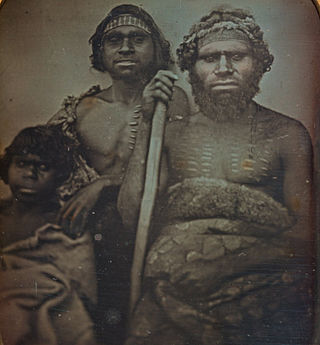
Koori is a demonym for Aboriginal Australians from a region that approximately corresponds to southern New South Wales and Victoria. The word derives from the Indigenous language Awabakal. For some people and groups, it has been described as a reclaiming of Indigenous language and culture, as opposed to relying on European titles such as "Aboriginal". The term is also used with reference to institutions involving Koori communities and individuals, such as the Koori Court, Koori Radio and Koori Knockout.

Gary Edward Foley is an Aboriginal Australian activist of the Gumbainggir people, academic, writer and actor. He is best known for his role in establishing the Aboriginal Tent Embassy in Canberra in 1972 and for establishing an Aboriginal Legal Service in Redfern in the 1970s. He also co-wrote and acted in the first Indigenous Australian stage production, Basically Black.
The Cadigal, also spelled as Gadigal and Caddiegal, are a group of Indigenous people whose traditional lands are located in Gadi, on Eora country, the location of Sydney, New South Wales, Australia.
SBS Audio is an Australian radio network and audio service owned by the Special Broadcasting Service directed towards newly arrived immigrants in Australia. It began as two stations based in Melbourne and Sydney, set up to provide pre-recorded information about the then-new Medibank health care system in languages other than English. Nowadays, the network targets the estimated 4+ million Australians who speak a language other than English at home with programs in 68 languages.
First Nations Radio, formerly, Radio Larrakia, is an Aboriginal Australian community radio station in Darwin, Northern Territory with a broadcast range that reaches Jabiru.

National Indigenous Television (NITV) is an Australian free-to-air television channel that broadcasts programming produced and presented largely by Aboriginal and Torres Strait Islander people. It includes the six-day-a-week NITV News Update, with programming including other news and current affairs programmes, sports coverage, entertainment for children and adults, films and documentaries covering a range of topics. Its primary audience is Indigenous Australians, but many non-Indigenous people tune in to learn more about the history of and issues affecting the country's First Nations peoples.
The National Black Theatre (NBT) was a theatre company run by a small group of Aboriginal people based in the Sydney suburb of Redfern which operated from 1972 to 1977. The original concept for the theatre grew out of political struggles, especially the land rights demonstrations, which at the time were being organised by the Black Moratorium Committee. The centre held workshops in modern dancing, tribal dancing, writing for theatre, karate and photography, and provided a venue for new Aboriginal drama. It also ran drama classes under Brian Syron, whose students included Jack Davis, Freddie Reynolds, Maureen Watson, Lillian Crombie, and Hyllus Maris.

Anita Marianne Heiss is an Aboriginal Australian author, poet, cultural activist and social commentator. She is an advocate for Indigenous Australian literature and literacy, through her writing for adults and children and her membership of boards and committees.
Radio Skid Row is a community radio station based in Marrickville, broadcasting to the Inner West suburbs of Sydney. This includes the former municipalities of Leichhardt and Marrickville, and the existing City of Sydney. Its broadcast signal can be received across much of Sydney, and its audience extends to many communities in Greater Western Sydney and, through online streaming, across the world.
The National Indigenous Radio Service (NIRS) is a satellite program feed available in Australia to Indigenous and non-Indigenous community radio stations. NIRS provides targeted and specialist programming for and by Australia's Aboriginal and Torres Strait Islander broadcasters. From its base in Brisbane NIRS provides a feed of programs and music supplied by a number of contributing stations including Koori Radio, 4AAA and BBM.
6AR was a community radio station based in Perth, Western Australia. It was operated by the Western Australian Aboriginal Media Association and was on air between 1994 and 2006.
Mark Ross, known as Munk or Munkimuk is a Sydney-based hip hop performer and music producer. He is known as The Grandfather of Indigenous Hip Hop and has been performing since 1984 as a breakdancer and rapping since 1988. He is known for his music production, MCíng, breakdancing, event hosting and radio broadcasting. He has also been quoted as an influence on quite a few Australian hip hop artists. He has been working in the music industry for 30 years and has mentored and produced countless artists and acts both in Australia and Asia.
Marlene Cummins is a jazz blues singer, saxophonist, songwriter, artist, Aboriginal Australian activist, broadcaster, dancer, and actor. Many activists consider her to be Australia's Angela Davis.
Solomon David Bellear was an Aboriginal Australian public figure.
Maureen Watson, also known as "Aunty Maureen", was a supporter of Aboriginal rights in Australia, actor, vocalist, writer, musician and storyteller.

Redfern Park is a heritage-listed park at Elizabeth, Redfern, Chalmers, and Phillip Streets, Redfern, City of Sydney, New South Wales, Australia. It was designed by Charles O'Neill. It was added to the New South Wales State Heritage Register on 21 September 2018.
Barbara McGrady is an Aboriginal Australian photographer and photojournalist based in Sydney, New South Wales. She is the first Indigenous Australian photojournalist.
Blak Douglas, formerly known as Adam Douglas Hill, is an Aboriginal Australian artist and musician. As of May 2022 he is based in Sydney, New South Wales.
Claude Williams is an Aboriginal Australian athlete who has played both rugby league and basketball for his home state of New South Wales, going on to become the first Aboriginal basketball coach in Australia.
Desperate Measures is an Australian television documentary series of historical and political matters relating to Indigenous Australians, with three series that aired on National Indigenous Television (NITV) between 2013 and 2018.





